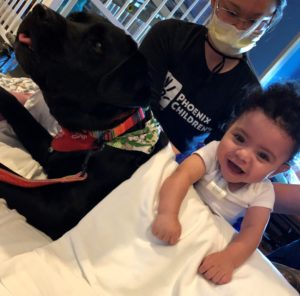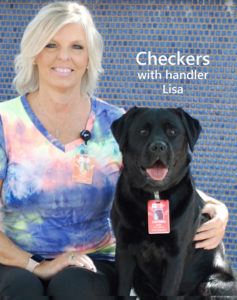Animal-assisted therapy offers hope and healing to patients at Phoenix Children’s
The Animal-Assisted Therapy Program at Phoenix Children’s brings just the right attention small patients need to feel more loved and comfortable at a hospital—all while improving their physical and mental conditions.
Phoenix Children’s Animal Assisted Therapy Program (AAT) currently has 36 volunteer therapy animals, including 34 dogs and two cats, all registered with Pet Partners or similar professional organizations, plus two full-time employed facility dog handlers and their specially trained dogs. When staff recognizes an opportunity to use animal-assisted therapy to benefit a patient, they enter a request just like an X-ray or a lab test. Then a coordinator matches a patient with the best therapy animal for the job and sends a team to the patient’s room with goals for a visit.
Courtesy of Phoenix Children’s Foundation
Mary Lou Jennings, Animal-Assisted Therapy Program Coordinator at Phoenix Children’s, remembers meeting a child and her family in the hallway who remembered the joy one of their therapy animals gave her.
“How wonderful is it that all a young patient can remember is ‘yeah, I was in the hospital, but they had dogs,’ She’s not scared of the hospital. It wasn’t a frightening experience. It’s not anything that she’s going to carry around for the rest of her life. That is huge!” she says.
Jennings says there’s lots of research that having touch or eye contact makes a difference in a patient’s experience. And if you can have something like pet therapy that stimulates a patient’s brain in a different way to think about something other than their current state—it improves a patient’s ability to cope.
Unique Human-Animal Bonds
 Jennings says the human-animal bond is strong and something many people have before they walk through hospital doors. Whether they had a pet at any time during their life or not, they’re coming into a very stressful environment and usually perk right up when they see a friendly animal.
Jennings says the human-animal bond is strong and something many people have before they walk through hospital doors. Whether they had a pet at any time during their life or not, they’re coming into a very stressful environment and usually perk right up when they see a friendly animal.
“I think if you can engage people in conversation about what life is like at home, you have an opportunity to establish rapport and then try to normalize their environment here with an animal,” she says.
The Animal-Assisted Therapy Program at Phoenix Children’s directly serves about 1,000 patients per month, and includes several parts:
- Volunteer AAT program — teams visit patients, families, and staff to help improve mood and provide distraction and motivation.
- Facility dog program — featuring Gertie and Checkers, two female black Labradors, plus two full-time dog handlers, is more targeted and individualized, serving between five and eight patients per day per animal.
- Virtual programming — broadcast via a closed-circuit TV system that can reach all patients, allowing kids to interact by phone with therapy-dog teams.
Animal-assisted therapy can offer patients in isolation a stop at the doorway, with a wave or trick in the hall from the volunteer therapy animal teams or provide a break for patients who may be waiting for surgery. The full-time facility dog teams have schedules that help create the opportunity for long-term relationships, which makes a big difference for patients who are on long-term stays. Animal-assisted therapy can even help infants who have come out of the NICU and need developmental help, by offering them sensory and tactile stimulation.
“We’ve provided training for our volunteer teams to be very involved and close with our patients, allowing the dog or cat to be with them on the bed,” Jennings says. “They’re very close and targeted in what they’re doing — which is not something many hospital programs do. A lot of them, because they don’t have the staff to train their volunteers, must do therapy dog visits in lobbies or common areas with all four feet on the floor — a different sort of interaction — whereas ours is more therapeutically based.”
NRC Health patient surveys show that the animals are a home run with patients:
“We love Phoenix Children’s! My son loved being able to spend time with therapy dog Tiana!”
“The attention and kindness they showed my daughter were wonderful. We also loved Mattie, the therapy dog that came to visit. It sure helped put my daughter at ease.”
“I love the idea of the volunteer dogs that come through to ease your child’s nerves before a procedure. Great program!”
And it’s not just a hit with patients — physicians love it too. In fact, providers often want the pet-therapy team to work with a patient first, because it makes it easier to establish rapport with the patient. For example, a doctor and patient can talk about the dog that just left the room and find something they have in common – a love of pets. It makes the next conversation that much easier.
Positive Change Backed Up by Research
 Jennings says that 20 years ago, pediatric healthcare systems had anecdotal or survey feedback from parents, but nothing quantitative enough to be deemed valid in the scientific minds that ran the systems. So, despite not being a researcher by trade, she dove into the topic area and conducted a collaborative research study, published in Comprehensive Psychoneuroendocrinology, to determine the effects of animal-assisted interactions on activity and stress responses in pediatric acute-care settings.
Jennings says that 20 years ago, pediatric healthcare systems had anecdotal or survey feedback from parents, but nothing quantitative enough to be deemed valid in the scientific minds that ran the systems. So, despite not being a researcher by trade, she dove into the topic area and conducted a collaborative research study, published in Comprehensive Psychoneuroendocrinology, to determine the effects of animal-assisted interactions on activity and stress responses in pediatric acute-care settings.
The randomized treatment-control trial measured 80 inpatient pediatric acute-care units, serving patients aged 2 to 19. The experimental group interacted with therapy-dog teams for five to ten minutes each, while comparison group patients continued their current activity without a visit. Salivary cortisol, activity level, and mood were assessed before and after animal visits. Animal-assisted interactions were found to decrease cortisol levels and increase mood and activity, benefiting all children in pediatric acute-care units.
“If you’re in a heightened state of arousal and anxiety, your body doesn’t do what it normally should do well,” Jennings explains. “It doesn’t circulate blood to all your extremities. It doesn’t digest food very well. There’s just a lot of basic functions it affects. If the body is shut down when you’re in that heightened state of tension and arousal from simply being in the hospital, that alone makes a difference.”
She says that just being able to make eye contact with an animal can make your oxytocin go up and your cortisol go down. “And that does a lot of good things for your body,” she adds. “It enhances your mood which may stimulate an interest in doing other things. So that was another huge success for us.”
It’s not unusual for parents to notice a change in their child after an animal-assisted therapy visit—and request more visits in the future.
“Parents have said, ‘I don’t know what’s been happening in the last two days since we’ve had these visits, but it’s made a huge difference. And can you come back tomorrow?’” Jennings says. “They saw a spark, or something that made their child want to get up and go down the hall or try the playroom. When pets help them feel better, they perk up and think, ‘Maybe I do want to get out of bed.’ That’s what we want to see, because it really makes a big difference to their healing.”
Did you know?

Funding for Jennings’s position came from a number of corporate and community supporters. These philanthropic efforts enable Phoenix Children’s to provide unique pet interactions. Having a full-time paid program coordinator has made a difference for this program. Jennings has drawn upon her two decades of experience to train many coordinators at other hospitals with animal-assisted therapy programs, ensuring that pet interactions can continue to make a difference nationwide.

 I am bubbly and get excited when I see a patient down the hall! You’ll know me when you see my eyes light up and my tail wiggle. I love to join Rachel, the Child Life Specialist, in helping patients through tough days or new procedures.
I am bubbly and get excited when I see a patient down the hall! You’ll know me when you see my eyes light up and my tail wiggle. I love to join Rachel, the Child Life Specialist, in helping patients through tough days or new procedures. I am very calm, but still like to get a smile out of my friends. I like to play with patients during rehab…sometimes they don’t even know we’re getting their therapy done! Gertie and I are full-time employees just like my person, Lisa, the Rehab Facility Dog Handler.
I am very calm, but still like to get a smile out of my friends. I like to play with patients during rehab…sometimes they don’t even know we’re getting their therapy done! Gertie and I are full-time employees just like my person, Lisa, the Rehab Facility Dog Handler.
